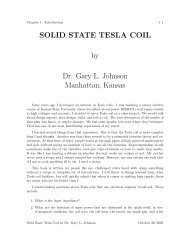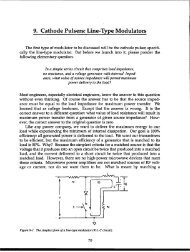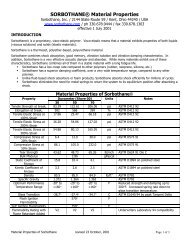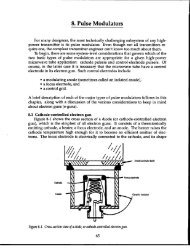3.6M north10.pdf - Dean-O's Toy Box
3.6M north10.pdf - Dean-O's Toy Box
3.6M north10.pdf - Dean-O's Toy Box
Create successful ePaper yourself
Turn your PDF publications into a flip-book with our unique Google optimized e-Paper software.
Cathode Pulsers: Hard-Tube Modulators (10) 155<br />
pulse, which is the time when the tube is ieast able to handle it. The MOV clamp<br />
voltage should be chosen so that the product of it and the minimum interpulse<br />
interval is as close to the product of pulse voltage and pulse duration as possible,<br />
making positive- and negative-going volt-time products equal across the transformer<br />
winding.<br />
10.3 Storage capacitors<br />
We all know that a capacitor is a device that consists of no more than two<br />
plates separated by dielectric material and is capable of storing energy in the<br />
electrostatic field between the plates. Nevertheless, entire books have been written<br />
on capacitor technology. What a transmitter designer is most concerned with<br />
is what the ratings of a capacitor mean and how the stress levels imposed affect<br />
capacitor performance.<br />
Generally speaking, the factor most important in determining a capacitor’s<br />
volume and cost is the energy it is capable of storing. This assumes, however,<br />
that once a capacitor is charged, its repetitive discharges will only be partial.<br />
(This was clearly not the case with the capacitors used to store energy in the<br />
PFNs of the line-type modulators. These capacitors were completely discharged<br />
each pulse during normal operation.) In addition, under some fault conditions<br />
the voltage can be reversed across the capacitor, which is one of the most stressful<br />
events a capacitor can experienc+and this applies to capacitors that are not<br />
inherently polarized, such as electrolytic types. These caveats both hint at the<br />
fact that even though the energy stored in a hard-tube modulator capacitor bank<br />
might be 10 to 20 times that stored in the PFN capacitance for comparable pulse<br />
energy, we are not talking about the same kind of capacitors. Pulse-formingnetwork<br />
capacitors are high-stress components whose failure rates cannot be<br />
overlooked. (Water-cooling such capacitors is not unheard of, and most of them<br />
are more correctly rated in shot life or number of pulses in a lifetime rather than<br />
number of operating hours in a lifetime.)<br />
On the other hand, capacitors for partial-discharge, or de-filter, service are<br />
usually rated for a given operational life, which can be tens of thousands of<br />
hours at a given terminal voltage. They come in standard case sizes that differ in<br />
energy-storage capability. The height of their bushings also varies, depending on<br />
operating voltage independent of stored energy. These capacitors are expected to<br />
be operated at their rated voltages. The deratings for life expectancy which<br />
primarily affect voltage stress in the dielectric material, have already been designed<br />
in. Operating them at reduced voltage will, of course, result in great<br />
extension of life but at the expense of their stored energy,, which varies as the<br />
square of the voltage.<br />
However, these capacitors are no more tolerant of voltage reversal than any<br />
other kind. They will be fully discharged by a short-circuit load fault or by the<br />
operation of an electronic crowbar switch. It is extremely important that there be<br />
sufficient resistance in series with the discharge loop so that the discharge is<br />
critically, or overly, damped in order to preclude voltage reversal. This means<br />
that the series inductance of the loop cannot be ignored. In most cases, the value<br />
of series resistance will depend upon the permissible peak fault current and will<br />
be safely above the value required for critical damping,







